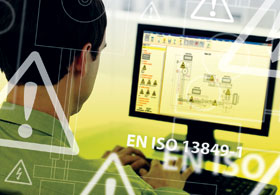

Rockwell Automation has enhanced its Safety Automation Builder (SAB) tool to include new additions to the safety function library and 16 additional languages; opening up this incredibly powerful safety system development tool, with new capabilities to new markets. The SAB software automates the safety-selection process to help speed system design and minimise human error.
With the SAB tool, users import an image of the machinery they wish to safeguard and answer questions using a drop-down menu and help screens to identify and select the necessary safeguards. The software then compiles all product selections, generates a bill of materials, and compiles necessary data to populate SISTEMA.
According to David Reade, business development consultant, safety and sensing, EMEA: “We’ve seen incredible uptake of this software package and with the additional functionality and language sets, the download figure is sure to get even bigger. One of the biggest advantages it offers is that it can act as a multi-language front end to the IFA’s SISTEMA software, a utility that provides developers and testers of safety-related machine controls with comprehensive support in the evaluation of safety in the context of ISO 13849-1.
“As SISTEMA has a limited language set, the use of SAB helps augment the process of report generation in additional languages,” Reade adds, “therefore, developers in more countries can now use SAB in their own language and then import this data to generate a final report. This is especially useful for cross-country projects where machines are being developed and exported. Inside the tool, you can have someone generate a file in Italy, this can then be sent to an end user in South Africa and SAB will automatically switch languages. SAB files can be transferred back and forth and, due to the cell-by-cell data entry, the translation does not change any of the functional data in the master file.
“We are seeing major take up of SAB across territories within large multinationals,” Reade explains. “By utilising SAB they can accept safety designs from a variety of OEMs in a common format. Using SAB, they can generate outline safety concepts for a machine in local languages and then export them to other design offices around the world. This approach cuts paperwork significantly.”
In addition to the enhanced language set, SAB also exhibits multiple additions to its extensive safety function library, a library of pre-configured, pre-engineered design documents containing detailed information for many safeguarding methods, including specific functionality, performance level category data and required input, logic and output components. These documents also include parts lists, electrical drawings, a SISTEMA project file, and verification and validation plans. The huge uptake of the software has also enabled Rockwell Automation to expand the help files based on extensive user experiences.
New SAB Languages include Portuguese, Spanish, French, German, Italian, Dutch, Czech, Swedish, Danish, Hungarian, Finnish, Romanian, Polish, Chinese, Japanese and Korean.
For more information contact Christo Buys, Rockwell Automation, +27 (0)11 654 9700, [email protected], www.rockwellautomation.co.za
| Tel: | +27 11 998 1000 |
| Email: | [email protected] |
| www: | www.rockwellautomation.co.za |
| Articles: | More information and articles about Rockwell Automation |

© Technews Publishing (Pty) Ltd | All Rights Reserved